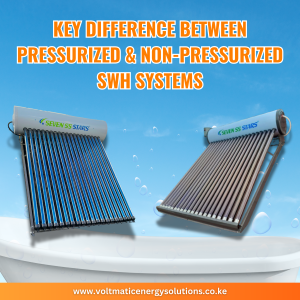Key Differences Between Pressurized and Non-pressurized Solar Water Heating Systems

Understanding the differences between pressurized and non-pressurized water heaters is essential for selecting the right system for your needs. Both types harness solar energy to heat water but operate on different principles, leading to distinct advantages and disadvantages.
Pressurized Solar Water Heating Systems
Pressurized solar water heaters utilize a pump to circulate water between the solar collectors and the storage tank, maintaining a constant pressure throughout the system. This design allows for efficient heat transfer and makes these systems suitable for various plumbing setups.
Advantages
- Efficiency: The pressurized system provides better heat transfer efficiency, allowing for quicker heating of water, which is particularly beneficial in areas with high hot water demand.
- Consistent Water Pressure: These systems maintain a consistent water pressure, making them ideal for multi-story buildings where reliable hot water supply is crucial.
- Integration with Existing Plumbing: Pressurized systems can be easily integrated into existing plumbing setups, making them a convenient choice for retrofitting.
Disadvantages
- Higher Cost: The complexity of the system, including pumps and pressure mechanisms, leads to higher installation and maintenance costs compared to non-pressurized systems.
- Power Dependency: Some models require electricity to operate the pump, which may not be ideal in areas with unreliable power supply.
Non-Pressurized Water Heating Systems
Non-pressurized solar water heaters, often referred to as passive systems, rely on natural convection to circulate water. This means that water flows from the collectors to the storage tank based on temperature differences, without the need for pumps.
Advantages
- Simplicity and Cost-Effectiveness: The absence of pumps and complex pressure systems makes non-pressurized systems simpler to install and generally more affordable.
- Lower Maintenance: With fewer components, these systems typically incur lower maintenance costs over their lifespan.
- Longevity: Non-pressurized systems often have a longer lifespan due to reduced stress on the tank and collectors from operating under lower pressure.
Disadvantages
- Limited Water Pressure: These systems can only provide low water pressure, which may not be suitable for all households, especially those with multiple bathrooms.
- Installation Height Requirement: For optimal performance, non-pressurized systems need to be installed at a higher elevation than the outlets to ensure adequate water flow, which can limit installation options.
Related Read: Difference Between Solar Water Heaters and Traditional Heating Systems
Conclusion
When choosing between pressurized and non-pressurized solar water heating systems, consider factors such as your household’s hot water demand, existing plumbing, installation costs, and maintenance preferences. Pressurized systems offer efficiency and consistent water pressure, making them suitable for larger households or multi-story buildings. In contrast, non-pressurized systems provide a more budget-friendly and low-maintenance option, ideal for areas with consistent sunlight and moderate hot water needs. Ultimately, the decision should align with your specific requirements and circumstances.
Contact Voltmatic Energy Solutions today for a free solar site analysis and personalized consultation.
Phone: 0759493610
Email: info@voltmaticenergysolutions.co.ke
